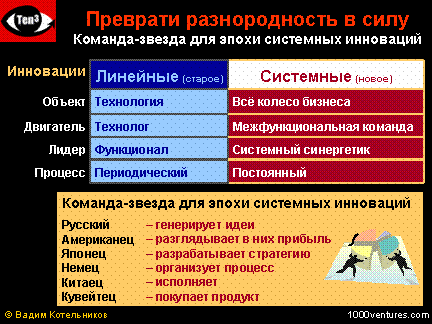|
Harnessing the Power of Diversity Leveraging the Power of Integrated Opposites |
|
By Vadim Kotelnikov, Founder, The first-ever BUSINESS e-COACH for Innovative Leaders, 1000ventures.com
"What sets GE apart is a culture that uses diversity" - Author
|
Diversity Defined Diversity is a specialized term describing a workplace that includes:
Leveraging Opposite Forces You can find a strategic competitive advantage in an organizational and cultural context by seeking to leverage, rather than diminish, opposite forces. "An important but widely overlooked principle of business success is that integrating opposites, as opposed to identifying them as inconsistencies and driving them out, unleashes power. This is true on both a personal level (the balanced manager is more effective than his or her peer at one end of the control spectrum) and on organizational level as well... On an organization level we accept the existence of hard and fast dichotomies because this binary perspective helps to rationalize personal styles, viewpoints, and structures. Polarized thinking is simplistic and misleading. In the business world, ideal approaches are generally painted in gray as opposed to black and white."3 To be successful in today's complex, rapidly changing and highly competitive world, you must embrace and manage critical opposites. Integrated Diversity "Integrated diversity" is a term used by Jack Welch, the legendary former CEO of General Electric, to define a learning culture. He described "integrated diversity" as the elimination of boundaries between businesses and the transferring of ideas from one place in the company to another. "Integrated diversity means the drawing together of our thirteen different businesses by sharing ideas, by finding multiple applications for technological advancements, and by moving people across businesses to provide fresh perspectives and to develop broad-based experience. Integrated diversity gives us a company that is considerably greater than the sum of its parts."4 Integrated diversity only works when the elements of that diversity, independent businesses, are strong in their own right. "GE wouldn't succeed by propping up small businesses with larger ones or having weaklings rely on winners. That was why Welch had always emphasized the importance of creating strong, stand-alone businesses."2 Case in Point: General Electric (GE) Jack Welch liked to say that GE's uniqueness was based on its being a multibusiness enterprises with a learning culture; that made its diversity a competitive advantage rather than a handicap. At General Electric (GE) the sum is greater than its parts as both business and people diversity is utilized in a most effective way. A major American enterprise with a diverse group of huge businesses, GE is steeped in a learning culture and it is this fact that makes GE a unique company. As Jack Welch puts it: "What sets GE apart is a culture that uses diversity as a limitless source of learning opportunities, a storehouse of ideas whose breadth and richness is unmatched in world business. At the heart of this culture is an understanding that an organization's ability to learn, and translate that learning into action rapidly, is the ultimate competitive business advantage." As Welch noted in his 1996 Letter to Share Owners, "The constant sharing of business experiences and cultural insights, from around the world, is creating a Company whose brains, as well as businesses, are truly global." The GE Leadership Effectiveness Survey (LES) provides a framework for evaluation of the corporate leaders that includes, inter alia, the following parameters: "Fully utilizes diversity of team members (cultural, race, gender) to achieve business success" and "Demonstrates global awareness / sensitivity and is comfortable building diverse / global teams." Case in Point: Hewlett-Packard Way To create an organization that could sustain its competitive advantage regardless of marketplace whims and what their competitors were building, HP founders based their corporate culture on the integration and reinforcement of critical opposites. This became known as the Hewlett-Packard Way. HP has achieved "what appears to be the greatest dichotomy: creating an environment that celebrates individualism, but at the same time one that is also wholly supportive of teamwork. Although HP people are taught to engage in cross-functional teams, they are also rated on the performance of decentralized business units and personal achievement."3...More |
Bibliography:
-
"Developing a Culture for Diversity in a Week", Chris Speechley and Ruth Wheatley, 2001
-
"Jack Welch and the GE Way", Robert Slater, 1999
-
"Extreme Management", Mark Stevens, 2001
-
Jack Welch, Letter to Share Owners in General Electric 1990 Annual Report



